The final part in the series. We’ll cover four categories of trainees, Fat & Weak, with its related category Obese, and two types of skinny-fat, which I define separately as Skinny-fat and Purgatory.
- What to do if you’re Overweight but New to Training.
- How to Avoid the Skinny-fat Trap and What to Do if you’re Stuck in it.
The latter two categories are going to apply to a lot of frustrated people, and while I may not have the answers you want to hear, I do have the answers that you need to if you’re going to break out of the cycle and finally start making progress. (Click for part 1 and part 2)
Category 6. Fat & Weak
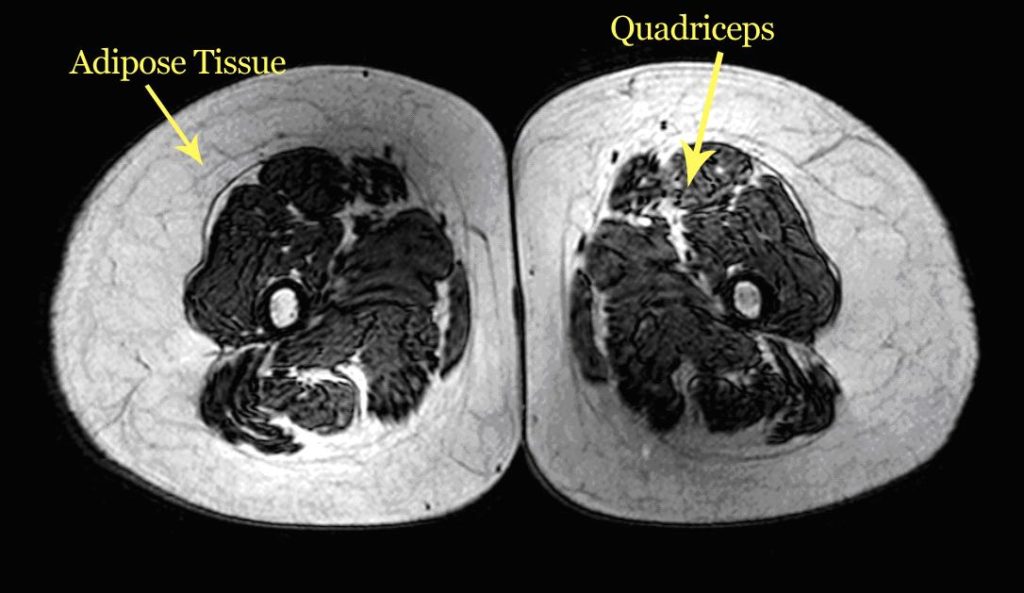
Strategy: Cut while consistently gaining strength
Alright, the category name doesn’t sound very appealing, but if this is you, you’re in a good spot. Of all the categories of trainee, it is you that has the most potential to drop the jaws of your relatives come this time next year. You’re new (or fairly new) to training, so you have all the newbie muscle gains to enjoy. You’re carrying a lot of extra fat, but that can be burned off relatively quickly. You’ll be lighter and stronger and notice a very real difference in how you look and feel each month for months to come.
How Quickly Can You Lose Fat/Gain Muscle?
People in this category are going to be around the 23-30% body-fat range, which means you can likely lose around 2lbs a week of body fat without risking muscle mass losses. However I really wouldn’t recommend going that high as you will critically hamper your newbie muscle growth potential, and it’s likely you’ll end up as a skinny-fat version of yourself that your doctor is more pleased about than you are.
I’d recommend keeping the target fat loss rate to between 1.25-1.5lbs a week of fat loss to prevent this. This way you’ll also avoid unnecessary hunger pangs and irritability that can come with higher deficits. – As with the “Fat but Muscled” category, ideally, we want it to feel almost like you’re not dieting for the longest time possible.
It is important to note that muscle growth is not going to be optimized when in a calorie deficit, so your potential for growth will be a little less than a beginner that is bulking which we covered in the previous parts. However, because of your relatively high body fat, you’re still likely to get close to that 2-3lbs/month of muscle gain that novice trainees can expect. This is because though you have insufficient energy going into your mouth, the body has plenty of energy available in your body fat stores to fuel itself. This is a very different situation to the leaner novice who can’t simply eat a calorie deficit and expect to gain muscle.
Common Pitfalls for the “Fat & Weak” Category
1. Belief that you gain muscle very easily and therefore don’t need to strength train. – This is just hubris based in misunderstanding. What you thought was rapid muscle growth when you started training in the past was much more likely just the initial pump everyone experiences due to an increase in glycogen and water balance. The only reason it bothered you is because it made your jeans uncomfortably tight in the thighs and you were worried you’d have to shop for new ones, right? (I have yet to meet the man that complained that your arms and chest started exploding in size) Fortunately, you have a lot of fat on your thighs at the moment and this will cease to be a problem soon enough. Resistance training is essential for muscle mass retention when dieting. (You’ll experience this again much later on when you have a small waist but big strong legs, and find that there isn’t a single manufacturer out there for a reasonable price that will fit you)
2. Dieting too quickly, hampering the muscle gains you could have had. – For some time you can have your cake and eat it – both muscle gain and fat loss will be achievable – as long as you don’t get greedy or impatient and try to expedite this rate of fat loss. This is the perfect example situation where though you could get leaner quicker, you really don’t want to.
3. Purchasing a crap program, kidding yourself that it will suffice. – P90x is a notorious example. (It fails to work past a few weeks because it doesn’t allow for progressive overload)
All of these roads, though they appear to be quicker by those walking them, just lead you to the skinny-fat category.
Recommendations
- Start a sensible strength training program focussed on progressive overload.
- Work hard on practicing your form.
- Set yourself a weight loss target of somewhere between 3-5lbs per month. This is the expected fat loss minus potential muscle growth. The fatter and taller you are, the more you’ll shift expectations to the upper end of this range. (Fatter & Taller: 8lbs of potential fat loss – 3lbs of potential muscle gain / Leaner & shorter: 5lbs -2lbs)
Category 7. Obese
Meaning a body fat of over 30%, not what is culturally considered to be obese (~50%)
Technically this applies to 1/3 of the population in the USA, Canada, Australia and the UK.
Strategy: Change habits and mindset
You didn’t get obese overnight. There was a consistent calorie surplus consumed over a long, long time, and you need to consider carefully the foods, habits, and environmental factors that caused that.
Foods – You know what I’m going to say here – cut out any big and obvious junk. The 2litre a day coca-cola habit – swap it for diet and wean yourself off. Dessert with every meal? – start cutting down. Add more fresh vegetables into your diet and you’ll stay fuller longer. Try to eat mostly foods that your great-grandmother would recognize as food and that will take you a long way. Stick with that simple advice and see how far you get.
Habits & environment – This is not just about the food. Your habits are what make you and the environment is what shapes them. I have a good friend, Nabil, who has eaten himself into a mess over the last 5 years. He loves eating, and I worry that it’s slowly killing him. Text him the name of any city in the world you’re in when traveling, and he will have a list of “must-go-to” eateries noted. His habit when traveling is to make the vacations center around the food. He takes a lot of vacations. His environment, given that he lives in one of the oil-rich Arab desert cities, is not conducive to outdoor activity either, social life revolves around eating and drinking. That can work if you can exercise outside of that and control your portions, but he doesn’t seem to be able to. The answer in Nabil’s case is not to focus on changing his foods, but to first work on changing his habits and environment (or the way he thinks about them) which is obviously easier said than done. This isn’t my area of expertise, so I won’t talk any further on it.
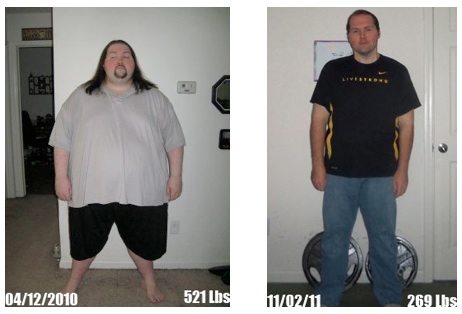
Recommendations
I always suggest the simplest approach for people, because changing one habit at a time is far more effective. Many folks out there may look to trick you into doing something complicated so they can just make a sale. I hate that, don’t fall for it.
Implement the following steps one at a time. Resist the temptation to skip to step three. – adding in too much complication right now is not only unnecessary, but it’ll backfire when you can’t sustain it.
1.a. Consider a routine like Starting Strength, 3 days a week. Barbells preferably, but if you struggle with flexibility then it’s perfectly fine to do bodyweight squats and work into dumbbell goblet squats (for example). Getting into the lifting and exercise mindset is of equal importance to the training effect itself.
1.b. Start cutting out the obvious crap in your diet. Work towards a target of eating a diet that is comprised of 80% fresh foods, real food, not twinkies, and other stuff in boxes. If you drink a lot, cut back a little. Work towards this 80% target over the next month.
When the weight loss stalls:
2. Follow the guides on the site. Start with my simple set-up guide. Consciously count calories and work to increase your protein intake. The calorie recommendations in my nutritional hierarchy of importance series are of primary concern, macros second. Read the third part for the common sense approach to vegetable intake and implement it. Timing is pretty much irrelevant to your results at the moment so I wouldn’t worry about it too much. Fasting (skipping breakfast or the ESE method above) may help you to control hunger, but it’s not going to magically make you lean by itself. Thus, if you want to skip breakfast and eat two meals a day, do it. Prefer not to? Fine. Doesn’t matter at this point and worrying about any differences just feeds that procrastination muscle.
Bear in mind that you’re likely to be carrying more muscle mass than the ‘Fat & Weak’ category guy because you will have built up some more muscle as a necessity to move yourself. Your expected rate of muscle growth will be lower, and because of all the fat that you will lose you probably won’t be able to measure or notice it. Thus, scale weight and strength gains are the most important barometers of progress for you. Don’t exceed 2lbs a week of fat loss for skin elasticity reasons.
Common Pitfalls for the “Obese” Category
Often it’s the mental aspects, rather than the technical, that hold people back. Dick Talens has some excellent articles about this on his blog, and JC Deen’s recent short book is the best and most applicable I’ve read on the subject. Highly recommended.
Category 8. Skinny-fat
Body fat 12-23%
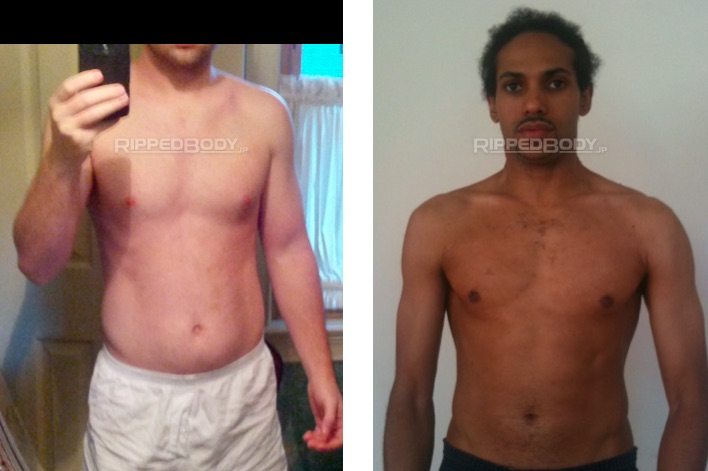
Strategy: Chase a recomp
Skinny-Fat Type 1
The strategy for the skinny-fat guy should be to chase muscle gain while losing fat. Most people in this category will be best to go with a slight calorie deficit, while pushing hard with your lifts so that you gain strength, which will drive the muscle growth. This works in beginners and novices nearly always, and can work for more advanced trainees too. However this isn’t always successful in practice for two primary reasons:
1. It is working, but the guy is tracking things so poorly that he can’t see it’s working, or the progress is just too slow for the unrealistic expectations that he set for himself initially. – This leads people into a program hopping spiral.
2. The guy is too far along with their training and they can no longer have their cake and eat it – a choice needs to be made between losing fat OR gaining muscle. (There is no clearly identifiable point that this will happen. Some people have it easier than others genetically and a whole bunch of other factors influences it – diet set-up, training, sleep-stress-recovery, mental aspects, etc.). I categorize these folks as being in Purgatory, because that’s often how these guys feel. We’ll cover these Skinny-Fat Type 2 people in the next section.
What do you mean by a recomp?
‘Recomp’ comes from the word ‘body-recomposition’ meaning that muscle growth takes place at the same time as fat is lost. This is not a reference to a calorie setting where there will be no weight change. Sometimes a recomp will be best achieved through a calorie surplus, sometimes it will be maintenance calories, and often it will mean a slight calorie deficit. Which it is for you depends on your body-fat level and training status.
A skinny category guy (see the previous article) will often achieve what visually appears to be a recomp through a calorie surplus.
A skinny-fat guy, somewhere in the 12-23% body-fat range, will have a calorie deficit scaling with how much fat he carries. At the bottom end of the range there will not be a calorie deficit (and thus no change in weight), at the top end of the range there will be a calorie deficit targeting between 0.75-1.0lbs of weight loss per week on average. In other words: The skinny-fat guy carrying more body fat should have more of a calorie deficit than the leaner guy.
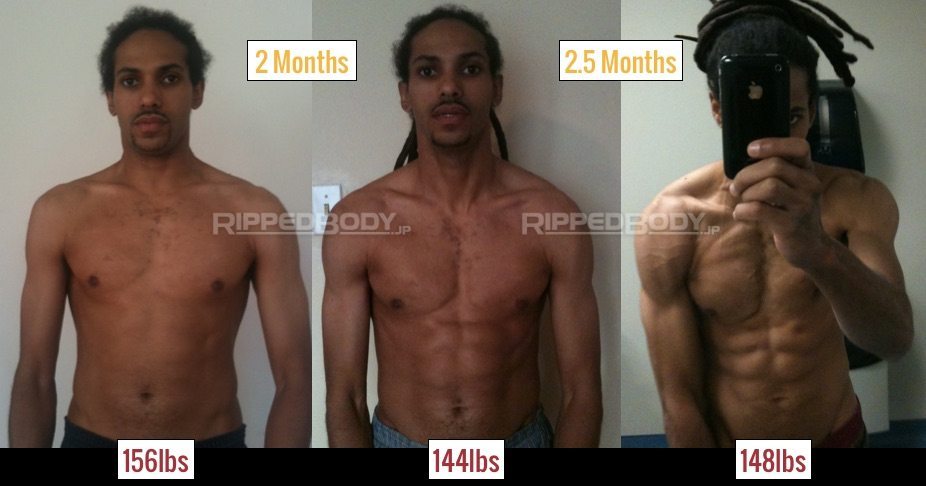
.
How quickly can I change?
Muscle can be created more slowly than fat can be burned off. Fat comes off from most areas of the body. Thus you’re in for a possibly frustrating period where, though your stomach measurements change, your limb measurements probably won’t change by much, and might even go down depending on how much fat you’re carrying to start with. If you recall that MRI from further up the post you’ll see why – the fat is being replaced by the muscle. This is one of the few times where calipers can prove to be a useful way to track progress, but only if you have access to someone that has experience using them, and only if you’re at or under 15% body fat.
Practically then, the best way to gauge progress is by your strength gains, and stomach measurement decreases. When you can no longer keep up this recomp effect, you’re into the Skinny-Fat Type 2 category and need to make a decision between muscle growth or fat loss.
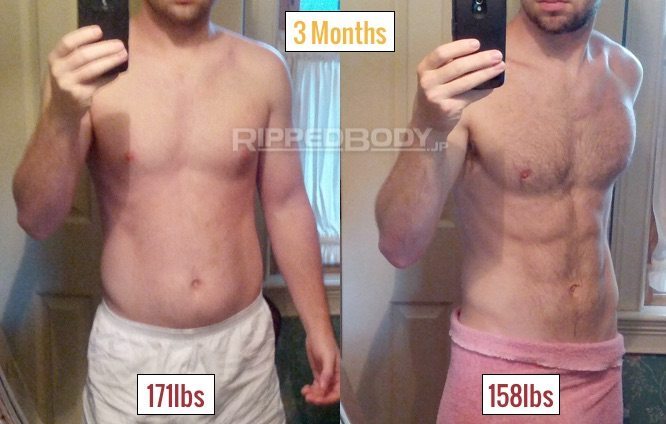
Common Pitfalls for the “Skinny-fat” Category
1. Lack of patience. – This is fed by the over expectations fed by the industry to beginners.
2. Program hopping.
3. Not training for strength. – If you don’t you not only remove a key piece of tracking data, but an important motivational tool for yourself. There will be weeks where the measurements and scale weight show little change and you wonder if you’re doing everything right. But if you are getting progressively stronger then you know that there are changes taking place under the skin that you simply haven’t been able to detect. Subjective assessment, such as the mirror each day when you get out of the shower, is not recommended and will only likely screw with your head, but photos taken months apart are useful. You can pinch yourself and know that you feel harder and more muscled under the skin, but that’s not nearly objective enough to be considered a way to measure progress.
Recommendations
Set your calorie level to between 0-1lbs of weight loss depending on where you are in the 12-23% body fat range. As always, if after several weeks your initial calculations yield more or less on average, adjust upwards or downwards later accordingly.
Train hard, work to get stronger, and work to keep progressing (always with good form) for as long as you can.
Category 9. Limbo/Purgatory
Body fat 12-18% (typically)

Strategy: Make a clear decision, cut or bulk (usually cut) & follow through with it.
Skinny-Fat Type 2
For these guys, the recomp strategy of the skinny-fat guy hasn’t worked or has ceased working and they are faced with making a choice between losing fat or gaining muscle.
How much fat we put on with each pound of muscle we gain comes down to how well we can partition calories. The cleverness of diet set up and genetics aside, a big determinant of that is believed to be our current body-fat level. In general, the leaner we are, the better our calorie partitioning and the less fat we’ll gain when bulking.
So, @18% body fat if you bulk over the course of the next 6 months by ~20lbs, even if you do everything perfectly, more of those 20lbs of gain will be fat than if you had started at ~10% body fat. The thing is because we can’t measure body fat changes accurately you’re unlikely to realize the difference in outcome between the two strategies until you cut and see what is left once the fat is gone. So you’re either going to take my word for it, or you’ll find out the hard way. So, now that you know this, and you know that 20lbs of weight gain for you at 18% and at 10% is going to yield different amounts of muscle growth, you could simply say, “Ok then, I’m just going to gain 30lbs while chasing my strength targets.” – That is a very valid and very real option, but it comes with the health risks associated with fat gain, particularly the visceral fat (around the organs) that starts to build up after the 15% body-fat level.
In this linear model then you are left with two options: you can either get leaner than you like, probably getting to the point of feeling a little skinny, on your way to your ‘jacked and ripped‘ end-goal, or you get fatter than you like on your way there. The net result is the same, it just depends on your preference after weighing up the options on how you wish to get there.
The problem comes when people don’t realize that they need to make a temporary trade-off and they end up spinning their wheels: they stop part way through their bulk because they feel they’re getting fat; they stop part way through their cut because they feel they are getting too thin. They’re right in both cases, but assuming they’ve explored all the other logical options, it’s simply tough shit for the time being.
I categorize these folks as being in Purgatory.
If this is you, it’s not a bad thing as long as you acknowledge and accept it, then start working towards the best you.
| Training status (per Berkhan’s strength standards) | Happiness scale when shredded (in smileys) |
| Novice/ beginner | 🙁 |
| Intermediate | :/ or 🙂 |
| Advanced | 🙂 or 😀 |
| Highly advanced | 😀 or 😛 |
Common Pitfalls for the “Purgatory” Category
1. The same three pitfalls of the skinny-fat guys. (Lacking patience, program hopping, not training for strength)
2. Failure to follow through with your goal, cut or bulk, once you’ve decided it.
Recommendations
- Bearing in mind what I have said above, choose one of the two options, bulk or cut, and prepare yourself mentally for a period of discomfort, whether that be feeling too fat or feeling too thin.
- If you cut, cut until you can see your abs clearly before starting to slow-bulk. (You can use the two clients’ levels of definition in this section as an example of what you need to shoot for). Aim to maintain your strength (but obviously, take the strength gains if they do happen to come). Do not shoot for an end weight target because you likely carry more fat than you think.
- If you decide to bulk, either decide on some reasonable strength targets (see my Training status vs Happiness scale when shredded table), or shoot for a sensible weight-gain target (base this on guidelines in the ‘skinny‘ category from part 2 of this series). Fix these now and only start your cut when you achieve them.
- Continue to progress with slow-bulk and cut cycles, keeping within a 9-15% body fat boundary. This is based on Lyle’s general recommendation from the articles that I mentioned above to keep calorie partitioning at it’s optimal.
There are no genetically gifted folks in this Purgatory category
Recall my bellcurve of genetic potential graph from the first article. Remember, most of the guys in this industry, if not chemically enhanced, have above average genetics. They are solidly in the yellow zone, purgatory does not exist for these people and none of them can understand your feelings, worries and concerns.
Here are two real-world examples of guys that have found themselves in this category.
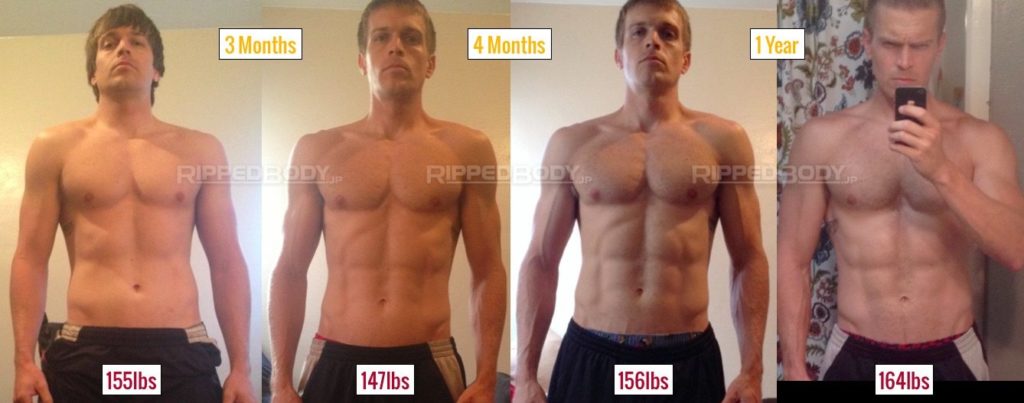
Chandler (above) has a genetically average disposition to muscle growth. I’d say he’s in the middle of the orange section. He had to get leaner than he wanted in order to go on to crush a slow bulk.
Brad (below) has a genetically under-average disposition to muscle growth. He’s probably somewhere on the middle-to-right side of the red section, and so the point where a recomp stopped working for Brad was earlier (in terms of muscular development) than with Chandler. There was little that he could do about this except for suck it up for a little longer and accept occasional negative comments from people that couldn’t understand the strategies and reasons for what he was doing. I salute Brad and people like him that have the patience to follow through with the plan. You can see how they are rewarded for it.
In both cases, they decided to give their genetics the middle finger and are on their way to creating great ideal physiques.
Hard work, patience, and consistency will win out over someone with better genetics but a lousy work ethic, so don’t give yourself excuses.
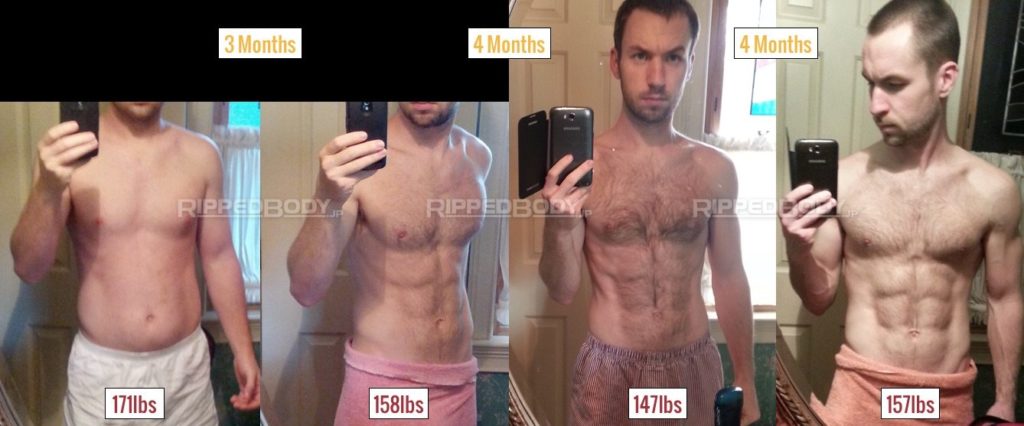
One FAQ
Can you tell me my body type if I tell you details in the comments?
I won’t. This is because it partially comes down to your personal preferences, and doing so takes a lot of time. Now, while it is true that I make clear suggestions for potential clients, that’s after a conversation/interview, with detailed and supporting reasons.
********
Thank you for reading this series. I hope you’ve found this helpful and inspiring. It’s honestly been a pleasure writing it and sharing these more specific things that I’ve learned through coaching people. I intend for this to be a linchpin article for the rest of the guides on the site, something that you will come back and refer to again and again.
Questions, as always, are welcomed in the comments. Our Facebook page has a good community spirit, and I thank everyone for increasingly making it a pleasure to check in to over recent months.
↓ What are you waiting for? Go get those gainz! ↓

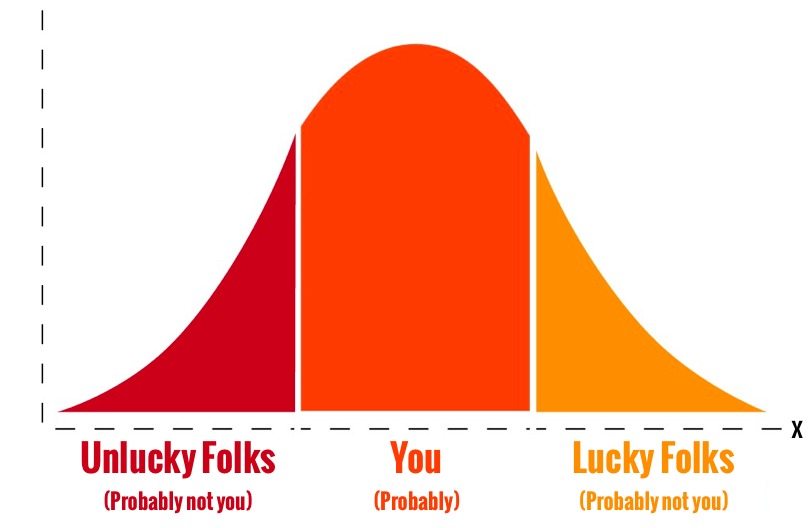
Privacy policy.